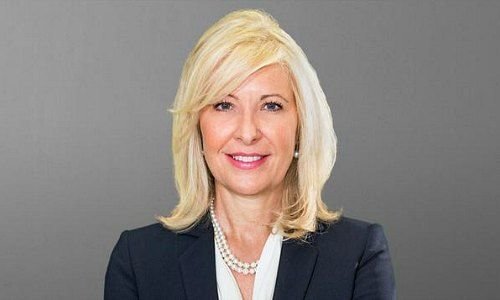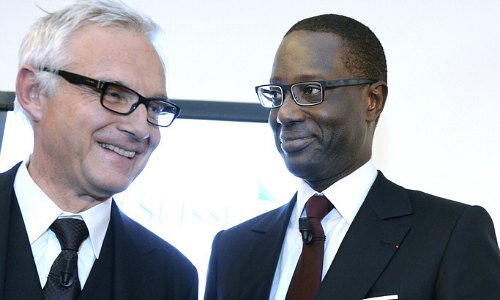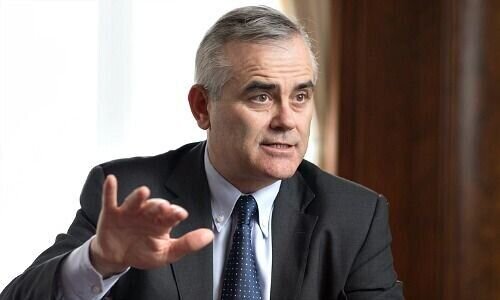The Swiss bank is mired in Greensill's collapse as well as Archegos' billion-dollar unraveling. Signs began mounting as far back as 12 months ago, shortly after Thomas Gottstein took over as CEO.
Thomas Gottstein's appointment of CEO of Credit Suisse in February of last year was meant to mark a new era, after the 165-year-old Swiss lender's reputation was badly tarnished in «spygate,» or corporate surveillance at least two top executives.
Instead, less than four weeks into the job for Gottstein, Covid-19 mushroomed into a pandemic. The CEO faced a crisis of as-yet unknown proportions – and not of his doing. From there, Credit Suisse bumbled through a series of accidents of its own making, culminating in the current crisis. The escalating crisis, in time lapse:
March 25, 2020: Swiss government unleashes a $42 billion loan scheme for small businesses, in which Gottstein was instrumental in lobbying for.

April 1, 2020: Credit Suisse client Luckin Coffee (pictured above) is found to have inflated sales. The Swiss bank had touted founder and billionaire Lu Zhengyao as a «dream» client in the mold of its one-bank strategy.
April 29, 2020: British financial outlets report on circular flows between Credit Suisse, Greensill Capital, and Japan's Softbank (pictured below, CEO Masayoshi Son) and its Vision Fund. The Swiss bank enables its Greensill funds to finance start-ups which Softbank had invested in – while a Greensill investor. Credit Suisse CEO later orders a review of the knotty ties.

June 25, 2020: Wirecard files for insolvency. Credit Suisse had structured a 900 million euro ($1.1 billion) fundraising for the German payments firm by Softbank in 2019, then sold to institutional investors.
July 19, 2021: Softbank pulls out of the Credit Suisse-Greensill funds, but the Swiss bank appears to make no other changes to the $10.1 billion line of products.
July 30, 2020: In a bid to streamline Credit Suisse's capital markets unit, Gottstein merges its investment bank with a separate trading unit underBrian Chin. Credit Suisse also fuses its risk and compliance departments, under top executive Lara Warner (pictured below), for savings.

September 1, 2020: Credit Suisse CEO discloses an ongoing review of the bank’s asset management strategy, dubbed the «Varvel barbell».
October, 2020: Warner, Credit Suisse’s risk manager, signs off on $160 million bridge loan to Greensill Capital ahead of the finance boutique’s planned 2021 public stock-listing.
November 24, 2020: Credit Suisse flags a $450 million write-off on its stake in York Capital, an U.S. hedge fund which is winding down.
December 15, 2020: Credit Suisse top executive Eric Varvel calls the supply chain funds an «innovative, higher-margin offering» in a presentation to Credit Suisse investors.
January 8, 2021: Credit Suisse warns investors it will swing to a first-quarter loss on the York write-down as well as roughly 1 billion Swiss francs in provisions to set aside legal and regulatory issues dating back to the 2008/09 crisis.
February 11, 2021: Credit Suisse pays $600 million to bond insurer MBIA in a 12-year legal battle over mortgage securities in the run-up to the 2008/09 financial crisis.

February 28, 2021: Credit Suisse suspends the Greensill supply chain funds, now holding $10.1 billion in investor money.
March 1, 2021: Credit Suisse says it will wind down the Greensill funds, with which it had also populated its other fixed income funds.
March 3, 2021: Bafin files a criminal complaint against Greensill Bank AG in Bremen. The German financial regulator had already evaluated the bank mid-2020 after its balance sheet swelled massively.
March 5, 2021: Credit Suisse says it will liquidate the Greensill supply chain funds. It isn't clear how much investors will receive.
March 8, 2021: Greensill Capital files for U.K. administration

March 9, 2021: Credit Suisse removes Michel Degen (pictured above) and other asset management executives close to the funds
March 17, 2021: Credit Suisse discloses pay clawbacks on top executives, warns investors the bank’s damage from Greensill will be «material,» that clients may pull their money, and that Swiss regulator Finma is requiring extra capital. A board-led group begins an internal investigation.
March 26, 2021: Greensill files for bankruptcy protection in the U.S. Credit Suisse reportedly estimates the fallout as high as $3 billion.
March 29, 2021: Credit Suisse issues profit warning due to Archegos, a hedge fund controlled by former «tiger cub» Bill Hwang, which is behind a fire-sale of assets.

March 30, 2021: Credit Suisse’s second-largest shareholder criticizes the Swiss bank’s risk controls «at every level» and calls for Chairman Urs Rohner (pictured above, at left, with previous CEO Tidjane Thiam) to forgo any further pay before exiting in April.
March 31, 2021: Standard & Poor’s and Moody’s both downgrade Credit Suisse’s outlook while equity analysts estimate the potential financial hit from Archegos. The bank’s shares lose one-fifth of their market capitalization – $5.3 billion – over the matter.
April 6, 2021: Two Credit Suisse top executives resign, the bank reneges on two-thirds of its dividend, halts an 1.5 billion Swiss franc buyback, and begins two separate investigations into Greensill and Archegos.

April 7, 2021: Credit Suisse CEO Gottstein (pictured above) tells a Swiss daily that «nothing is sacred» in a strategy review under incoming Chairman António Horta-Osório, but seems to back the «one-bank» strategy.
(Images: Keystone, Credit Suisse)



































